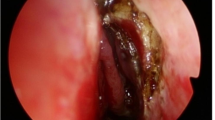Abstract
Currently, transnasal approaches are preferred widely for treating chronic dacryocystitis. Restenosis which count for the most common causes of failure in endoscopic dacryocystorhinostomy (EDCR) reduces the success rate. We intended to make a large fistula, potentially minimizing granulation tissue, and synechiae by means of creating a large bony ostium and preserving mucosal flaps and intubation with silicone tube (STI). In this study, long-term follow-up results of EDCR with mucosa preservation were discussed. 126 patients underwent endonasal DCRs from January 2004 to March 2009. A large ostium was created preserving mucosa; nasal and lacrimal flaps were approximated and the new ostium was stented with silicone tube. Surgical success rate was 93 % with STI and with preservation of nasal and lacrimal flaps. In conclusion, EDCR is an easy surgical procedure with low complication rates. Intranasal pathologies can also be corrected in the meantime. Success depends on creating a large bony ostium and preventing restenosis. EDCR preserving nasal and lacrimal flaps with STI is recommended as an alternative procedure in chronic dacryocystitis with high success rates.





Similar content being viewed by others
References
Caldwell GW (1893) Two new operations for obstruction of the nasal duct, with preservation of the canaliculi, and with an incidental description of a new lachrymal probe. Am J Ophthalmol 10:189–193
Toti A (1904) Nuovo Metodo conservatore dicura radicale delle suppurazione croniche del sacco lacrimale (dacricistorhinostomia). Clin Moderna (Firenza) 10:385
McDonogh M, Meiring JH (1989) Endoscopic transnasal dacryocystorhinostomy. J Laryngol Otol 103:585–587
Hurwitz JJ, Archer KF (1988) Double stent intubations in difficult post traumatic dacryocystorhinostomy. Ophtalmic Surg 19:33–36
Zilelioğlu G, Tekeli O, Uğurbil SH, Akıner M, Aktürk T, Anadolu Y (2002) Result of endoscopic endonasal non-laser dacryocystorhinostomy. Doc Ophtalmol 105:57–62
Onerci M (2002) Dacryocystorhinostomy. Diagnosis and treatment of nasolacrimal canal obstruction. Rhinology 40:49–65
Becker BB (1992) Tricompartment model of the lacrimal pump mechanism. Ophtalmology 99:1139–1145
Dresner SC, Klussman KG (1991) Outpatient dacryocystorhinostomy. Ophtalmic Surg 22:222–224
Gonnering RS, Lyon DB, Fisher JC (1991) Endoscopic laser-assisted lacrimal surgery. Am J Ophthalmol 111(2):152–157
Velodios A, Hervey JT (1991) Long term placement of silastic nasolacrimal tubes. Ophtalmic Surg 22:225–227
Mcdonogh M, Meiring JH (1989) Endoscopic transnasal dacryocystorhinostomy. J Laryngol Otol 103:585–587
Linberg JV, Anderson RL (1982) Study of intranasal ostium external dacryocystorhinostomy. Arch Ophtalmol 100:1758–1762
Mannor GE, Millman AL (1992) The prognostic value of preoperative dacryocystography in endoscopic intranasal dacryocystorhinostomy. Am J Ophthalmol 113:134–137
Tsirbas A, Wormald PJ (2003) Endonasal dacryocystorhinostomy with mucosal flaps. Am J Ophthalmol 135:76–83
Wormald PJ (2002) Powered endoscopic dacryocystorhinostomy. Laryngoscope 112:69–72
Zilelioğlu G, Uğurbaş SH, Anadolu Y, Akıner M, Aktürk T (1998) Adjunctive use of mitomycin C on endoscopic lacrimal surgery. Br J Ophthalmol 82:63–66
Unlü HH, Toprak B, Aslan A, Güler C (2002) Comparison of surgical outcomes in primary endoscopic dacryocystorhinostomy with and without silicone intubation. Ann Otol Rhinol Laryngol 111:704–709
Yuen KS, Lam LY, Tse MW, Chan DD, Wong BW, Chan WM (2004) Modified endoscopic dacryocystorhinostomy with posterior lacrimal sac flap for nasolacrimal duct obstruction. Hong Kong Med J 10:394–400
Trimarchi M, Resti AG, Bellini C, Forti M, Bussi M (2009) Anastomosis of nasal mucosal and lacrimal sac flaps in endoscopic dacryocystorhinostomy. Eur Arch Otorhinolaryngol 266(11):1747–1752
Massegur H, Trias E, Adema JM (2004) Endoscopic dacryocystorhinostomy: modified technique. Otolaryngol Head Neck Surg 130:39–46
Wu W, Cannon PS, Yan W, Tu Y, Selva D, Qu J (2011) Effects of Merogel coverage on wound healing and ostial patency in endonasal endoscopic dacryocystorhinostomy for primary chronic dacryocystitis. Eye (Lond) 25(6):746–753
Author information
Authors and Affiliations
Corresponding author
Rights and permissions
About this article
Cite this article
Çukurova, I., Caner Mercan, G., Çetinkaya, E. et al. Endoscopic dacryocystorhinostomy: outcomes using mucosal flap preserving technique. Eur Arch Otorhinolaryngol 270, 1661–1666 (2013). https://doi.org/10.1007/s00405-012-2285-z
Received:
Accepted:
Published:
Issue Date:
DOI: https://doi.org/10.1007/s00405-012-2285-z




